NVIDIA GeForce GTX 680 Review: Retaking The Performance Crown
by Ryan Smith on March 22, 2012 9:00 AM ESTCompute: What You Leave Behind?
As always our final set of benchmarks is a look at compute performance. As we mentioned in our discussion on the Kepler architecture, GK104’s improvements seem to be compute neutral at best, and harmful to compute performance at worst. NVIDIA has made it clear that they are focusing first and foremost on gaming performance with GTX 680, and in the process are deemphasizing compute performance. Why? Let’s take a look.
Our first compute benchmark comes from Civilization V, which uses DirectCompute to decompress textures on the fly. Civ V includes a sub-benchmark that exclusively tests the speed of their texture decompression algorithm by repeatedly decompressing the textures required for one of the game’s leader scenes. Note that this is a DX11 DirectCompute benchmark.
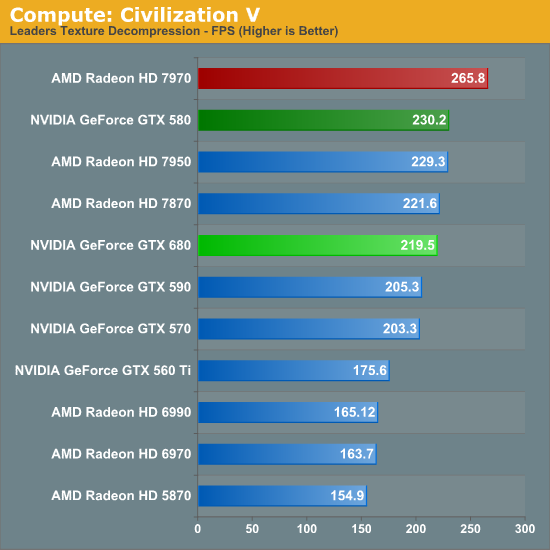
Remember when NVIDIA used to sweep AMD in Civ V Compute? Times have certainly changed. AMD’s shift to GCN has rocketed them to the top of our Civ V Compute benchmark, meanwhile the reality is that in what’s probably the most realistic DirectCompute benchmark we have has the GTX 680 losing to the GTX 580, never mind the 7970. It’s not by much, mind you, but in this case the GTX 680 for all of its functional units and its core clock advantage doesn’t have the compute performance to stand toe-to-toe with the GTX 580.
At first glance our initial assumptions would appear to be right: Kepler’s scheduler changes have weakened its compute performance relative to Fermi.
Our next benchmark is SmallLuxGPU, the GPU ray tracing branch of the open source LuxRender renderer. We’re now using a development build from the version 2.0 branch, and we’ve moved on to a more complex scene that hopefully will provide a greater challenge to our GPUs.
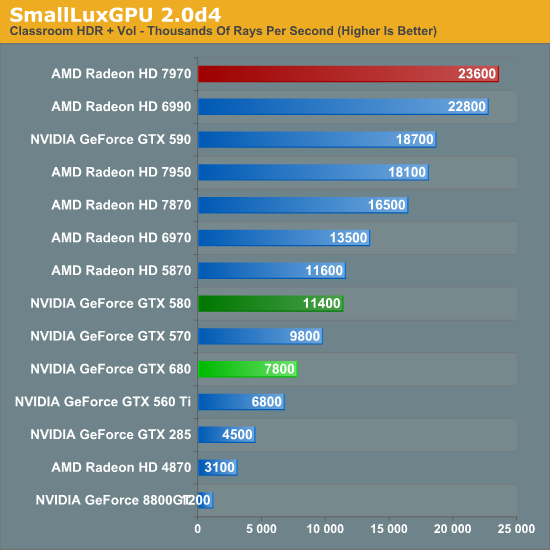
CivV was bad; SmallLuxGPU is worse. At this point the GTX 680 can’t even compete with the GTX 570, let alone anything Radeon. In fact the GTX 680 has more in common with the GTX 560 Ti than it does anything else.
On that note, since we weren’t going to significantly change our benchmark suite for the GTX 680 launch, NVIDIA had a solid hunch that we were going to use SmallLuxGPU in our tests, and spoke specifically of it. Apparently NVIDIA has put absolutely no time into optimizing their now all-important Kepler compiler for SmallLuxGPU, choosing to focus on games instead. While that doesn’t make it clear how much of GTX 680’s performance is due to the compiler versus a general loss in compute performance, it does offer at least a slim hope that NVIDIA can improve their compute performance.
For our next benchmark we’re looking at AESEncryptDecrypt, an OpenCL AES encryption routine that AES encrypts/decrypts an 8K x 8K pixel square image file. The results of this benchmark are the average time to encrypt the image over a number of iterations of the AES cypher.
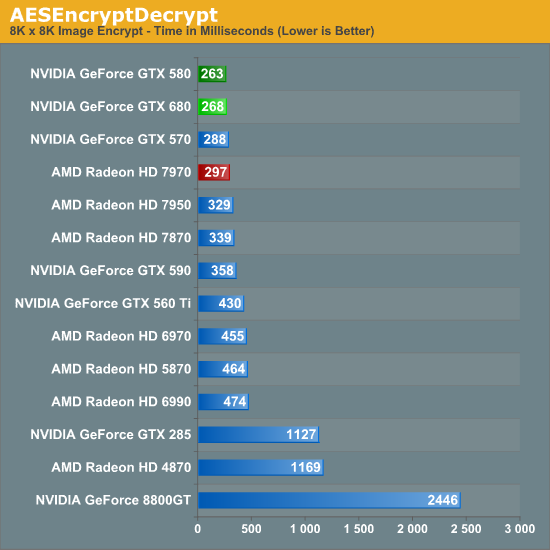
Starting with our AES encryption benchmark NVIDIA begins a recovery. GTX 680 is still technically slower than GTX 580, but only marginally so. If nothing else it maintains NVIDIA’s general lead in this benchmark, and is the first sign that GTX 680’s compute performance isn’t all bad.
For our fourth compute benchmark we wanted to reach out and grab something for CUDA, given the popularity of NVIDIA’s proprietary API. Unfortunately we were largely met with failure, for similar reasons as we were when the Radeon HD 7970 launched. Just as many OpenCL programs were hand optimized and didn’t know what to do with the Southern Islands architecture, many CUDA applications didn’t know what to do with GK104 and its Compute Capability 3.0 feature set.
To be clear, NVIDIA’s “core” CUDA functionality remains intact; PhysX, video transcoding, etc all work. But 3rd party applications are a much bigger issue. Among the CUDA programs that failed were NVIDIA’s own Design Garage (a GTX 480 showcase package), AccelerEyes’ GBENCH MatLab benchmark, and the latest Folding@Home client. Since our goal here is to stick to consumer/prosumer applications in reflection of the fact that the GTX 680 is a consumer card, we did somewhat limit ourselves by ruling out a number of professional CUDA applications, but there’s no telling that compatibility there would fare any better.
We ultimately started looking at Distributed Computing applications and settled on PrimeGrid, whose CUDA accelerated GENEFER client worked with GTX 680. Interestingly enough it primarily uses double precision math – whether this is a good thing or not though is up to the reader given the GTX 680’s anemic double precision performance.
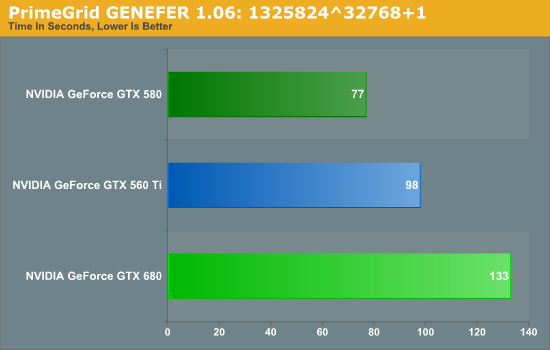
Because it’s based around double precision math the GTX 680 does rather poorly here, but the surprising bit is that it did so to a larger degree than we’d expect. The GTX 680’s FP64 performance is 1/24th its FP32 performance, compared to 1/8th on GTX 580 and 1/12th on GTX 560 Ti. Still, our expectation would be that performance would at least hold constant relative to the GTX 560 Ti, given that the GTX 680 has more than double the compute performance to offset the larger FP64 gap.
Instead we found that the GTX 680 takes 35% longer, when on paper it should be 20% faster than the GTX 560 Ti (largely due to the difference in the core clock). This makes for yet another test where the GTX 680 can’t keep up with the GTX 500 series, be it due to the change in the scheduler, or perhaps the greater pressure on the still-64KB L1 cache. Regardless of the reason, it is becoming increasingly evident that NVIDIA has sacrificed compute performance to reach their efficiency targets for GK104, which is an interesting shift from a company that was so gung-ho about compute performance, and a slightly concerning sign that NVIDIA may have lost faith in the GPU Computing market for consumer applications.
Finally, our last benchmark is once again looking at compute shader performance, this time through the Fluid simulation sample in the DirectX SDK. This program simulates the motion and interactions of a 16k particle fluid using a compute shader, with a choice of several different algorithms. In this case we’re using an (O)n^2 nearest neighbor method that is optimized by using shared memory to cache data.
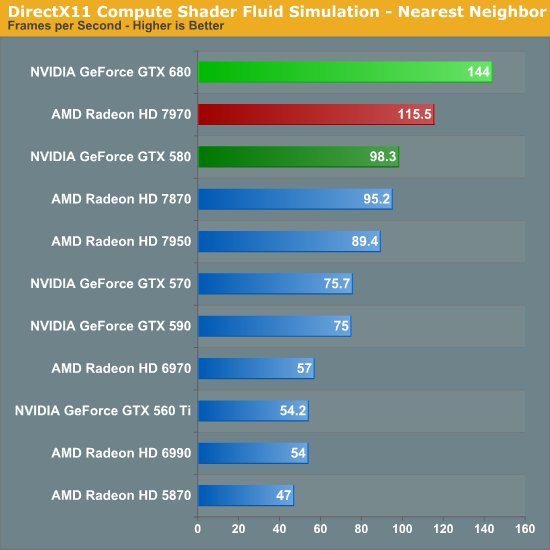
Redemption at last? In our final compute benchmark the GTX 680 finally shows that it can still succeed in some compute scenarios, taking a rather impressive lead over both the 7970 and the GTX 580. At this point it’s not particularly clear why the GTX 680 does so well here and only here, but the fact that this is a compute shader program as opposed to an OpenCL program may have something to do with it. NVIDIA needs solid compute shader performance for the games that use it; OpenCL and even CUDA performance however can take a backseat.










404 Comments
View All Comments
Hrel - Thursday, March 22, 2012 - link
It is a little weird that Nvidia gave up ground on the compute side, but their architecture is still vastly superior at tesselation. Which is the main point of DirectX11 and the biggest breakthrough in graphics in the past 12 years; maybe longer. AMD has improved that part of their GPU's quite a bit since the HD4000/HD5000 series; but they clearly still have a long way to go.Nvidia wins on every single front; this is why all my graphics cards are Nvidia now. I'm just glad AMD is so competitive, hopefully prices will start falling again, before December.
SydneyBlue120d - Thursday, March 22, 2012 - link
Hope to see some testing about video decoding and encoding, especially 4K compared with AMD cards :) Thanks :)shaggart5446 - Thursday, March 22, 2012 - link
seems like tom is getting paid just like fuddo where on earth could you say gtx680 is better than 7970 nediot pick your games them what to bench mark why did amd win in some test result shouldnt nediot wins all the bench mark if your gonna say gtx680 is fastersilverblue - Thursday, March 22, 2012 - link
No.CeriseCogburn - Thursday, March 22, 2012 - link
Obviously amd has been paying off Crysis and Metro game companies )CeriseCogburn - Thursday, March 22, 2012 - link
But not Crysis 2 game company which we can't benchmark anymore because amd can't play that modern title )edwpang - Thursday, March 22, 2012 - link
It'll be interesting to know the real engine clock these cards are running when testing, since GTX 680 has the "Boost Clock" feature.Ryan Smith - Thursday, March 22, 2012 - link
Unfortunately Precision X doesn't have any logging, so I don't have any precise numbers. However I did take notes from what I saw in Precision X during our testing, which I'm happy to post here (just keep in mind that they're my internal notes).----
Crysis: Generally sustained at 1097; fluctuates some at 2560 between 1071 and 1097 due to power load.
Metro: Frequently bounces between a range of 1045 to 1097.
Dirt 3: Bounces between 1084 and 1097.
Shogun 2: Fluctuates between 1071 and 1019; very high load.
Batman: Some fluctuating between 1097 and 107.
CivV: Mostly 1097; a few drops to 1084.
Portal 2: Between 1058 and 1006.
BF3: 1097 sustained
SC2: 1097 sustained
Skyrim: 1097 sustained
SLG: 1097 sustained
Everyone - Thursday, March 22, 2012 - link
"the GTX 680 is faster, cooler, and quieter than the Radeon HD 7970"Sounds just like the launch of the 5870. But here's the problem. I bought a 5870 over two years ago, in a decent sale which had it priced at $325. Just now, two years later, are we getting cards that beat its performance by a wide margin and make me feel like it's actually time to upgrade. But look at the pricing! The Nvidia 680 is $500. There still isn't a card out there at the price level I paid two years ago (a price level I feel very comfortable with in contrast to the over $500 card market which I view as 'high end out of my wallet range') gives me a decent jump in performance over my 5870.
I read every new videocard review anandtech posts, but I can't shake the feeling that something here is a little weird. In such a rapidly evolving market, why is it that two years later there hasn't been a realistic improvement in the level of graphics cards that I (and many others I'd imagine) am interested in?
prophet001 - Thursday, March 22, 2012 - link
talk to obama